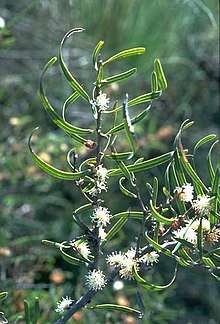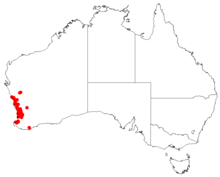Hakea stenocarpa
Hakea stenocarpa is a shrub in the family Proteacea, commonly known as narrow-fruited hakea.[2] It has scented creamy-white flowers in clusters, often with curling leaves and is endemic to an area in the Mid West, western Wheatbelt, Peel and the South West regions of Western Australia.
| Narrow-fruited hakea | |
|---|---|
 | |
| Hakea stenocarpa in the ANBG | |
| Scientific classification | |
| Kingdom: | Plantae |
| Clade: | Tracheophytes |
| Clade: | Angiosperms |
| Clade: | Eudicots |
| Order: | Proteales |
| Family: | Proteaceae |
| Genus: | Hakea |
| Species: | H. stenocarpa |
| Binomial name | |
| Hakea stenocarpa | |
 | |
| Occurrence data from Australasian Virtual Herbarium | |
Description
Hakea stenocarpa is a small, rounded multi-stemmed shrub typically grows to 0.3 to 1 metre (1 to 3 ft) high and forms a lignotuber. The branchlets are more or less smooth at flowering time. The inflorescence is a single raceme of 14-20 sweetly scented white, creamy-white or yellow flowers in leaf axils in the upper branchlets. The smooth pedicels are cream-white, the perianth cream-white and the pistil 4.4–5 mm (0.17–0.20 in) long. The linear leaves are 6–11 cm (2–4 in) long and 2–7 mm (0.08–0.3 in) wide with a prominent pale yellow longitudinal mid-vein. The leaves generally curl in an upward spiral. Unlike most species of hakea the fruit are long, narrow-ovoid, 2.8–3 cm (1.1–1.2 in) long and 0.6–0.8 cm (0.24–0.31 in) wide, tapering to a pointed beak. The fruit are rough and warty where they attach to the branches.[2][3]
Taxonomy and naming
Hakea stenocarpa was first formally described by Robert Brown in 1830 and published the description in Supplementum primum prodromi florae Novae Hollandiae.[4][5] The specific epithet is derived from the ancient Greek stenos (στενός), "narrow" and karpos (καρπός), "fruit",[6][7] referring to the shape of the fruit.[2]
Distribution and habitat
Narrow-fruited hakea grows in heath, low open shrubland and woodland in deep sand, loam, clay and gravel sometimes over laterite. Requires a well-drained site in sun or partial shade. An ornamental shrub, may be used as a groundcover.[2]
Conservation status
Hakea stenocarpa is classified as "not threatened" by the Western Australian Government Department of Parks and Wildlife.[3]
References
- "Hakea stenocarpa". Australian Plant Census. Retrieved 27 August 2019.
- Young, J A. Hakeas of Western Australia:A Field and Identification Guide. J A Young. ISBN 0-9585778-2-X.
- "Hakea stenocarpa". FloraBase. Western Australian Government. Retrieved 27 August 2019.
- "Hakea stenocarpa". Australian Plant Name Index. Retrieved 27 August 2019.
- "Hakea stenocarpa". Biodiversity Heritage Library. Retrieved 27 August 2019.
- Francis Aubie Sharr (2019). Western Australian Plant Names and their Meanings. Kardinya, Western Australia: Four Gables Press. p. 313. ISBN 9780958034180.
- Backer, C.A. (1936). Verklarend woordenboek der wetenschappelijke namen van de in Nederland en Nederlandsch-Indië in het wild groeiende en in tuinen en parken gekweekte varens en hoogere planten (Edition Nicoline van der Sijs).